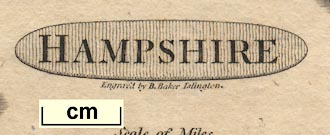
 Map Group BAKER 1792
Map Group BAKER 1792



It was published, coloured, by Darton and Harvey, 1804.





title
engraver

HAMPSHIREbelow which:-
Engraved by B. Baker Islington.
up is N
scale

Printed lower right is a scale line; chequered in miles, labelled at 2 mile intervals. The 10 miles = 34.4 mm gives a scale 1 to 467824 assuming a modern mile. The map scale is about:-
1 to 470000
7 miles to 1 inch

Printed in the map borders are scales of latitude and longitude for a rectangular projection; chequered at 2 minute intervals, labelled at 10 minute intervals, the degree labels in roman numerals. The bottom scale is labelled:-
Longitude West from London.As far as can be judged the
longitude, Winchester = 1 d 12 1/2m Wsuggesting a prime meridian in central London, not Greenwich.
The map covers 0d 42m to 1d 44m W, 50d 32m to 51d 26m N; the whole of Hampshire and the Isle of Wight.
sea plain
ENGLISH CHANNEL
SPITHEAD
Southampton Water
coast shaded

The coast line is shaded for emphasis extending into harbours and estuaries. There may be hachures along the coast line to suggest cliffs, eg:-

near Milton.
Harbours can be recognised but are not labelled. Numerous islands are shown in Portsmouth Harbour, and one in Langstone Harbour.
castles

Hurst Castle
Calshot Castle
bridges

Rivers are drawn by wiggly lines tapering inland. Some are labelled, eg:-
Avon R.
Test R.The Blackwater is labelled:-
Loddon R.Most of the main river systems are shown, but with no great accuracy or detail of tributaries. Bridges are not particularly noticed, but are implied by roads crossing rivers.
forests
trees

Wooded areas are shown by dense groups of little tree symbols. Only Woolmer Forest and Alice Holt, East Bere Forest, and the New Forest forests are drawn. Only:-
New Forestis labelled. Woolmer is shown dense with trees which it wasn't. The only other tree symbols are in parks.

Parks are shown in outline with fence palings; the interior pecked. There might be a block for a house, and might be some trees, for example by Alresford.

The county boundary is a bold dashed line. Adjoining counties are labelled, eg:-
WILTSHIREThe detached part of Hampshire in Sussex is not shown. Adjacent counties are labelled, eg:-
WILTSHIREA few towns and villages outside the county are marked to provide continuity to the road network, like other towns these may be labelled with name and distance from London, eg:-
Amesbury / 78
distances from London
electoral data

WINCHESTER / 65

Stockbridge / 67
Alton / 48Southampton is made an exception, it is a large town and is labelled in italic block caps:-
SOUTHAMPTON / 76The figures are the distance from London. Borough towns have stars attached to show the number of members sent to Parliament; Stockbridge has two for instance.

Lor. Wallop
Colemore

Roads are drawn by double lines. Roads are differentiated by width, the wider roads mostly having bold and light lines which is often used to mark turnpikes at this period. As well as main routes there is a network of smaller roads.

Worthy Dean Course(Worthy Down).
roman roads
roman towns

Silchester is marked by a block in a hachured ring, the roman town.
A very straight road is drawn aligned with Silchester and Salisbury, from about Ewhurst to near Quarley, labelled:-

Roman RoadThe main road from Winchester to Popham, continued as a small road towards Silchester to about Sherbourne, is labelled the same.





